Animals communicate danger through vocal alarm calls and visual signals, like tail flagging. These methods alert others about nearby threats, helping groups respond quickly. Birds share information about predator size and proximity with their calls, while mammals use tail movements to urge immediate action. Eavesdropping on alarm calls from different species enhances awareness and survival strategies. If you want to understand more about these fascinating communication methods, there's plenty more to discover.
Key Takeaways
- Animals use vocal alarm calls to indicate the presence and type of predators, aiding group reactions to danger.
- Visual signals like tail flagging prompt immediate responses, encouraging animals to freeze or flee from threats.
- Eavesdropping on alarm calls from other species enhances awareness of potential dangers and informs survival strategies.
- Alarm calls vary in context, allowing animals like chickadees to convey the size and threat level of nearby predators.
- Human noise pollution disrupts animal communication, making it harder for them to signal danger and impacting their survival.
Visual and Auditory Signals in Animal Communication
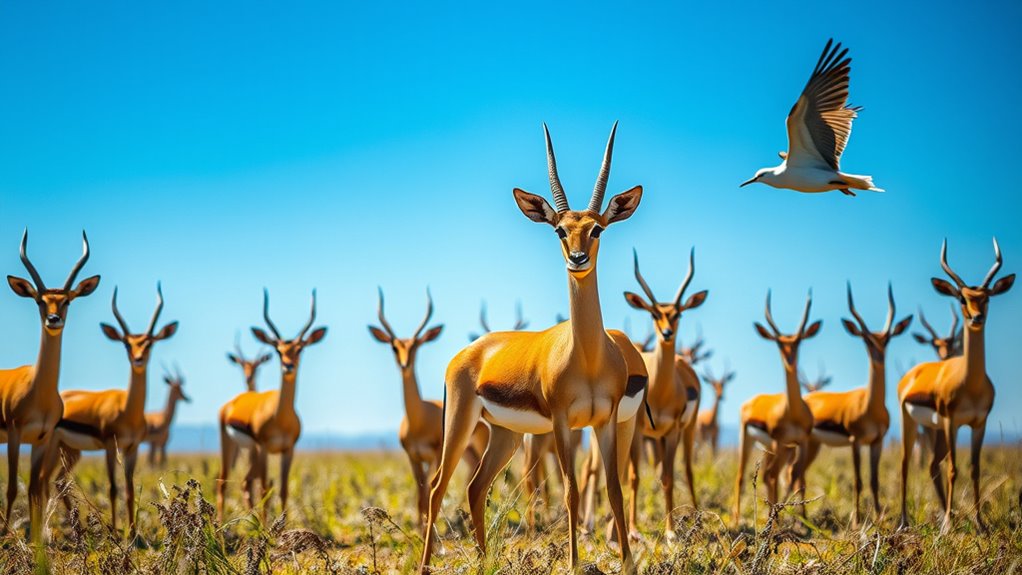
When animals sense danger, they often rely on visual and auditory signals to communicate with each other.
Birds, for instance, use specific vocal alarm calls to alert their flock about nearby predators. These calls can indicate the type and proximity of the threat, allowing birds to react accordingly. Some species, like chickadees, have distinct calls that convey details about the size and threat level of a predator, ensuring their group members know how to respond.
Additionally, visual signals, such as tail flagging in mammals, prompt immediate reactions, urging animals to freeze or flee. By using these communication methods, birds and other animals enhance their chances of survival in the face of danger.
The Role of Eavesdropping in Survival Strategies
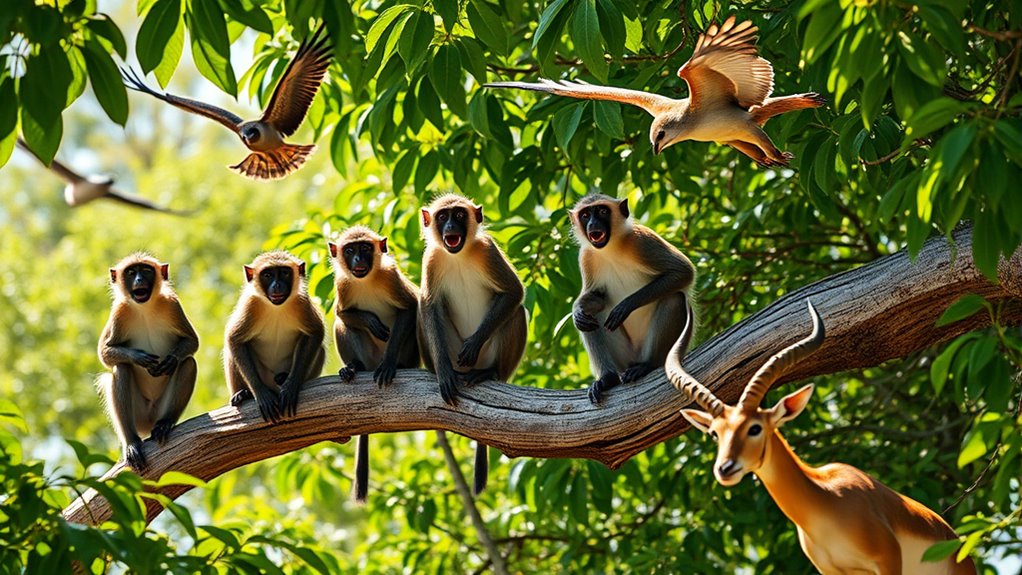
Eavesdropping plays an essential role in survival strategies among various animal species, as it allows them to gather important information about potential threats. When you listen to the alarm calls of others, like the superb fairy-wren, you can learn about dangers without facing them directly.
This eavesdropping behavior helps you associate unfamiliar calls with predators, enhancing your awareness. Additionally, animals often benefit from cross-species communication, responding collectively to threats by heeding signals from different species.
Alarm Calls: Language of Danger
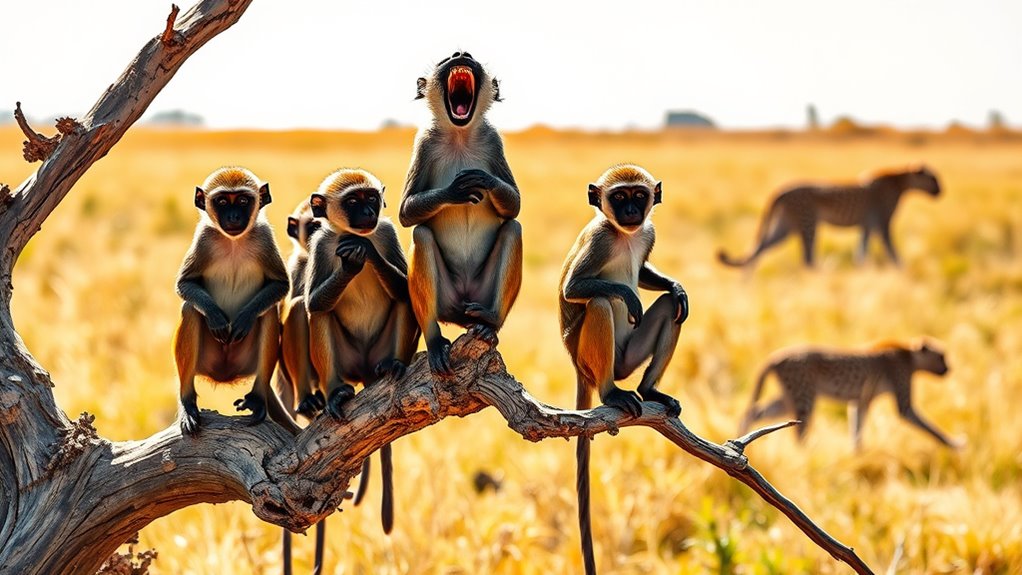
Alarm calls serve as an essential communication tool in the animal kingdom, signaling danger and ensuring survival. These specific vocalizations, used by various species, vary in context to indicate different levels of threat.
For instance, chickadees and red-breasted nuthatches convey predator size and threat level through their alarm calls, allowing others to react appropriately. Prairie dogs have a remarkable system, describing potential threats by size and even clothing color.
Alarm calls can travel long distances, helping maintain group cohesion and enhancing survival strategies among social animals. Additionally, when superb fairy-wrens eavesdrop on alarm calls from other species, they learn to associate unfamiliar sounds with danger, boosting their ability to avoid predators.
Alarm calls enhance survival by fostering group cohesion and enabling species to learn about dangers through eavesdropping.
This intricate communication is crucial for staying safe in the wild.
Impact of Human Noise on Animal Communication
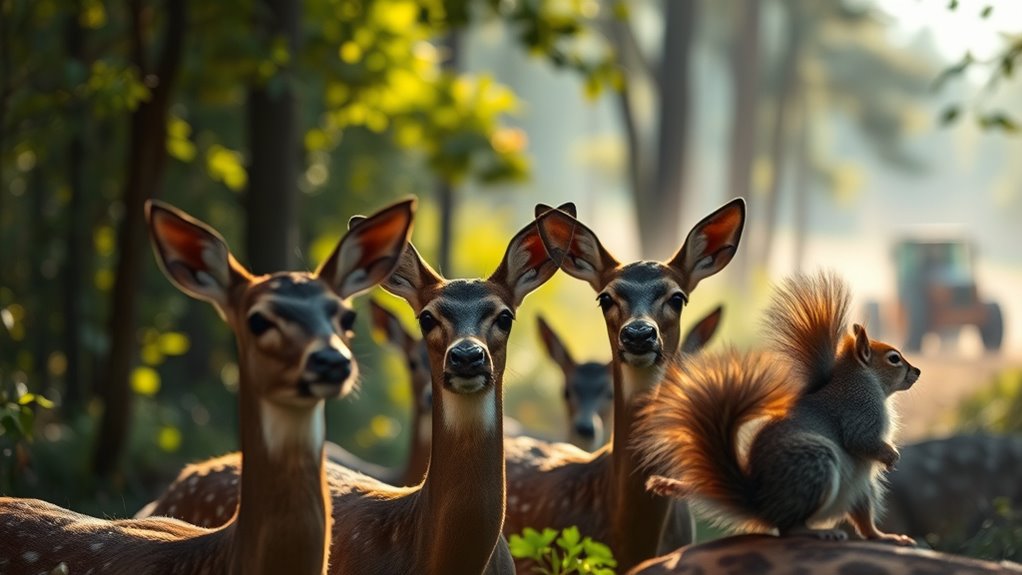
As human activities generate increasing levels of artificial noise, wildlife faces significant challenges in communication. Small birds, in particular, suffer as their crucial signals about danger and food become drowned out by highway sounds. This disruption can lead to severe consequences for their survival.
- Over 80% of U.S. land lies close to roads, complicating wildlife interactions.
- Noise pollution impacts foraging efficiency, leading to weight loss in migrating birds.
- Increased vigilance due to noise diverts time away from essential activities like feeding.
In noisy environments, small birds struggle to communicate effectively, which threatens their health and overall ecosystem dynamics.
Evolutionary Adaptations in Predator-Prey Communication
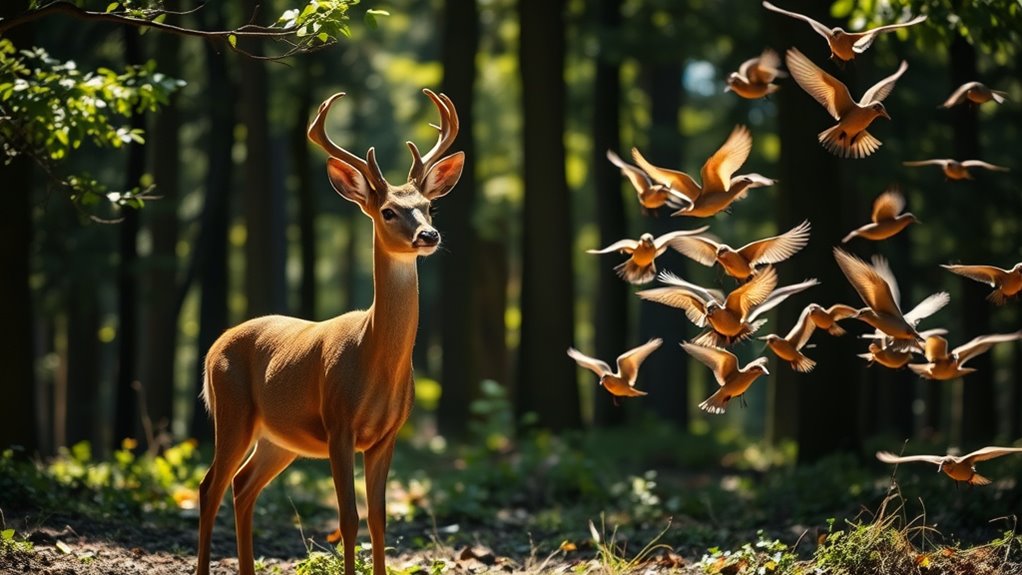
While predator-prey communication is often thought of as a simple exchange of signals, it involves a complex interplay of evolved behaviors that enhance survival.
Prey animals have developed alarm signals, like vocalizations and visual displays, to alert others of predators, improving group responses. Rattlesnakes exemplify this with their distinctive rattle, warning potential threats of their venomous nature.
Aposematic coloring in poisonous tree frogs visually warns predators, aiding in learned avoidance. Gazelles use stotting behavior, high jumps signaling their fitness, discouraging chases.
Additionally, Madagascar iguanas eavesdrop on flycatcher alarm calls, benefiting from other species' warning systems.
These adaptations in animal communication are essential for survival, illustrating the dynamic relationship between predators and their prey.
Frequently Asked Questions
How Animals Can Sense the Danger?
You might notice how animals sense danger through heightened awareness and keen instincts. They often rely on acute hearing to detect unusual sounds or movements that signal threats.
Many species use visual cues, like sudden changes in behavior or color, to alert others nearby. Additionally, some animals can pick up on chemical signals, such as pheromones, that warn of danger.
How Do Animals Alert Each Other to the Presence of Danger?
Animals alert each other to danger through various signals. You might notice birds using specific calls to indicate the type of predator nearby, prompting others to react.
Ground animals, like prairie dogs, employ a complex system of alarm sounds to describe threats in detail.
Even eavesdropping plays a role, as some species listen for warning signals from others, enhancing their own survival strategies.
This quick communication fosters group awareness and helps guarantee safety.
How Do Animals Know Danger?
Animals sense danger like a finely tuned instrument, picking up on subtle cues in their environment. They rely on instinct, using acute senses to detect changes in sounds, smells, and sights.
For instance, a rustling bush may send a shiver down their spines, signaling a lurking predator. Their brains process these signals quickly, triggering responses that guarantee survival, whether it's fleeing or freezing in place until the threat passes.
What Are the 4 Types of Animal Communication?
You might be surprised to learn that animals communicate in four main ways: visual, vocal, chemical, and tactile.
Visual signals include body language or displays that you can see, while vocal signals involve sounds, like calls or screams.
Chemical communication relies on pheromones, which are invisible signals that convey messages through scent.
Finally, tactile communication involves physical contact, like nudging or grooming, helping animals convey messages through touch.
Each method plays an essential role in their interactions.
Conclusion
In the grand tapestry of nature, animals weave intricate signals to safeguard one another from lurking threats. Their whispers and calls form a delicate language, a symphony of survival that echoes through the wild. As you observe these remarkable exchanges, remember that each chirp or rustle carries a deeper meaning, a gentle reminder of the bonds forged in the face of danger. By understanding their communication, you can appreciate the beauty of their world and the delicate dance of life.










